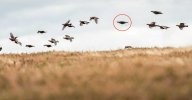What aspect(s) of aircraft design/operability is it that you believe cannot be plausible solely as a function of the shape of the Calvine "craft?" Aerodynamics? Structural? Stability? Controlability? Maintainability? Supportability? If it's not humanly plausible, there has to be a reason(s) within the realm of aerospace engineering as we know/practice it.
I'm not trying to pigeon hole you here
@Domzh, but as an aerospace engineer with over thirty years experience I'm trying to understand what is it about a "pyramid shaped bottom" in and of itself that makes such a design concept implausible. I see design challenges with that shape, but I'm not sure I'd call them insurmountable.
a pyramid bottom strikes me personally as a shitty and unlikely design for several reasons:
a) visibility. stealth / spy planes are designed to almost disappear in the sky. not only for radar but also the human eye. this is the exact opposite design
b) aerodynamics. assuming it has to follow our known physics, this design choice makes zero sense. not being as streamlined as possible, means it has to consume more fuel, consuming more fuel means less range
c) landing. given a pyramid bottom, means the landing gear must extend and cover a lot of distance, both horizontally and vertically to reach over the pointed middle part. this seams to be a rather fragile and or heavy (to counter it) landing gear construction. this becomes more ridiculous the larger the craft becomes.
d) form follows function. what is the function of a pyramid bottom design? so far i can only see negatives. the fact that we dont see this design anywhere else (tech usually has similar existent design as a predecessor) suggests further that it is less likely. even the silly avrocar flying saucer from the 50s had a more reasonable design.
these are my thoughts as a non-aerospace engineer. im an economist, so all i have is somewhat critical thinking and wondering about the "why".
maybe you as an expert in this field (no sarcasm intended) have come around similar designs in military application. no comic book and movie examples of course and after the invention of the f-117 and B-2.
you said there are some vtol jets that have a landing structure or something like that, could you provide an example?
i mean this shitty design from the 50s had a cart that had to carry it and it was launched vertically. pilots had to land it back on its tail. a pyramid has a pointed base, no matter if you orient it horizontally or vertically (assuming it didnt hover for 10min in a 45 degree position).
maybe you can explain the "why" for such a design choice?
maybe its also a boat, like these amphibian cars except it can also fly?
maybe thats how it has to look to create anti gravity fields? (russels tea pot reddit style discussion in this case).
(this shouldnt sound condescending or rhetorical by the way, im a non native english speaker and unfortunately am not as eloquent as i would like to be ;-) )




